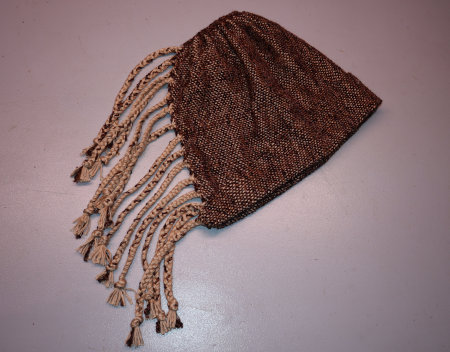As I whittle down my mending pile, I start to think seriously about my next weaving project. I have two things to draw on for inspiration: my new reeds and the recent sorting of my handspun yarns. Our cold winter weather is a factor as well, turning my thoughts to things warm and comforting. What I'm drawn to, is weaving a Saori cap (also known as a Su-chan or no-sew hat).
[SIDENOTE: I can't find a non-copyrighted image to show you the cap, so I'll refer you to photos via a links to Centering with Fiber. And a free PDF tutorial with pictures can be viewed here.]
Maybe I'd better start by explaining Saori weaving. Sometimes described as "zen weaving," "freeform weaving," or "free-style weaving," it's a contemporary idea developed by Misao Jo of Japan. "Saori" comes from the words, Sai, a Zen term which means "everything has its own dignity / beauty," and Ori, which is Japanese for "weaving." Saori looms have only two shafts and two treadles because the Saori philosophy emphasizes color and texture rather than a specific technique, structure, or style of weaving. It embraces individuality, and what others may call "mistakes." Basically, it means the weaver is free from rules and conventions to weave what and how they want.
The Saori cap is credited to Su-chan, who designed it in her Saori studio in Japan. Besides being attractive and perfect for handspun yarn, I think the design is exceedingly clever (as are all garments designed with Saori fabrics). The waste warp before and after the woven fabric is incorporated into the cap as fringe which can be braided or twisted or whatever. I love anything that decreases waste!
Directions and descriptions of weaving and making the cap still leave me with questions, so I decided to try a test cap first. I have quite a few small lots of commercial yarns, and have chosen a couple of possibilities for weaving, making, and sizing a sample cat cap (spell checker didn't catch that one).
 |
| The novelty yarn on the left is actually navy blue, not black. |
I think any of these color combinations would be fun to weave with. The solid color yarns are a cotton/bamboo blend, which I'd use for the warp. The textured yarns are poly/acrylic yarn and would probably be best for the weft. Once I get the size right, I'll make one with handspun wool, which will be much warmer!
Related post
























